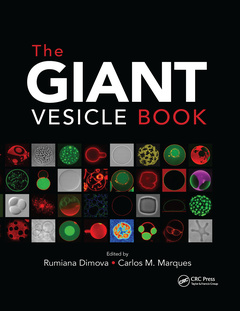Description
The Giant Vesicle Book
Coordinators: Dimova Rumiana, Marques Carlos
Language: English
Subjects for The Giant Vesicle Book:
Keywords
DNA Origami; Fatty Acid Vesicles; giant vesicles; ITO Slide; lipid membranes; Guv; membrane models; giant unilamellar vesicles; Spontaneous Curvature; giant plasma membrane vesicles; Optical Tweezers; Protein reconstitution; American Chemical Society; GUVs; Indium Tin Oxide Plates; cytoskeleton; Optical Trap; membranes; Micropipette Aspiration; vesicles; Vesicle Dynamics; cells; Daughter Vesicles; Particle-membrane interactions; Lipid Bilayer Membrane; polymer-membrane interactions; Frap Experiment; GUV-based techniques; POPC Vesicle; optical microscopy; DC Pulse; synthetic lipid membranes; Actin Filaments; Atomic force microscopy; Actin Cortex; Vesicle fluctuation analysis; Peg Rich Phase; membrane nanotubes; Vesicle Deformation; Hydrophobic Block; Protein-membrane interactions; Vesicle Shape; Lipid-polymer interactions; Membrane Tension; synthetic biology; Area Dilation; membrane composition; Raman; NMR; electron microscopy; mass spectroscopy
Publication date: 06-2022
Support: Print on demand
Publication date: 10-2019
· 21.6x28 cm · Hardback
Description
/li>Contents
/li>Biography
/li>
Giant vesicles are widely used as a model membrane system, both for basic biological systems and for their promising applications in the development of smart materials and cell mimetics, as well as in driving new technologies in synthetic biology and for the cosmetics and pharmaceutical industry. The reader is guided to use giant vesicles, from the formation of simple membrane platforms to advanced membrane and cell system models. It also includes fundamentals for understanding lipid or polymer membrane structure, properties and behavior. Every chapter includes ideas for further applications and discussions on the implications of the observed phenomena towards understanding membrane-related processes. The Giant Vesicle Book is meant to be a road companion, a trusted guide for those making their first steps in this field as well as a source of information required by experts.
Key Features
? A complete summary of the field, covering fundamental concepts, practical methods, core theory, and the most promising applications
? A start-up package of theoretical and experimental information for newcomers in the field
? Extensive protocols for establishing the required preparations and assays
? Tips and instructions for carefully performing and interpreting measurements with giant vesicles or for observing them, including pitfalls
? Approaches developed for investigating giant vesicles as well as brief overviews of previous studies implementing the described techniques
? Handy tables with data and structures for ready reference
Preparation methods for giant unilamellar vesicles. Preparation and properties of giant plasma membrane vesicles and giant unilamellar vesicles from natural membranes. Protein reconstitution in giant vesicles. GUVs with cytoskeleton. Understanding giant vesicles – a theoretical perspective. Simulating membranes, vesicles, and cells. Theory of vesicle dynamics in flow and electric fields. Particle-membrane interactions. Theory of polymer-membrane interactions. Application of optical microscopy techniques on giant unilamellar vesicles. Mechanics assays of synthetic lipid membranes based on micropipette aspiration. Atomic force microscopy of giant unilamellar vesicles. Manipulation and biophysical characterization of GUVs with an optical stretcher. Vesicle fluctuation analysis. Using electric fields to assess membrane material properties in GUVs. Creating membrane nanotubes from GUVs. Measuring GUV adhesion. Phase diagrams and tie lines in GUVs. Vesicle dynamics in flow: an experimental approach. Membrane permeability measurements. Lipid and protein mobility in GUVs. Shining light on membranes. Protein-membrane interactions. Effects of antimicrobial peptides and detergents on guvs. Lipid-polymer interactions: effect on GUVs shapes and behavior. Polymersomes. Giant hybrid polymer/lipid vesicles. Giant unilamellar vesicles: from protocell models to the construction of minimal cells. Encapsulation of aqueous two-phase systems and gels within giant lipid vesicles. Droplet-supported giant lipid vesicles as compartments for synthetic biology. List of lipids and physical constants of lipid bilayers. List of membrane dyes and fluorescent groups conjugated to lipids. List of detergents. List of water-soluble dyes or their fluorescent groups and their structures
Rumiana Dimova leads an experimental lab in biophysics at the Max Planck Institute of Colloids and Interfaces in Potsdam, Germany. She has been working with giant vesicles already from the beginning of her scientific career. After being introduced into the magic of their preparation during her studies as a student in Bulgaria, she remained fascinated by their application and over the years pursued a variety of projects employing giant vesicles as a platform to develop new methods for the biophysical characterization of membranes and processes involving them. Until now, these studies have resulted in more than hundred peer-reviewed publications. Recently, she was also awarded the Emmy Noether distinction for women in physics of the European Physical Society.
Carlos Marques, a CNRS senior scientist, founded the MCube group at the Charles Sadron Institute in Strasbourg, France, where he gears experimental and theoretical research towards the understanding of the physical properties of self-assembled lipid bilayers. Trained as a polymer theoretician, Carlos first got interested in membranes because they interact with polymers and published the first prediction for the membrane changes expected when polymers adsorb on lipid bilayers. He then expanded the scope of his group to include experiments and numerical simulations, and has now published many papers based on research with giant unilamellar vesicles, including the first study of lipid oxidation in GUVs and the discovery of the so-called PVA method for vesicle growth.

